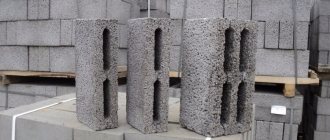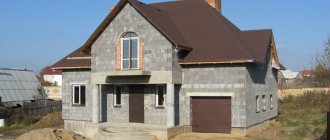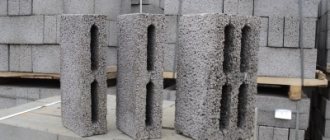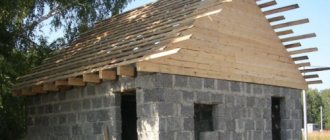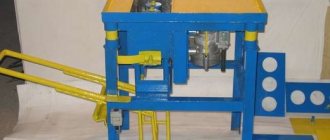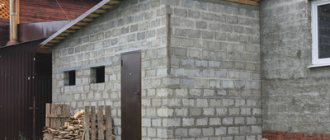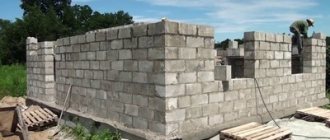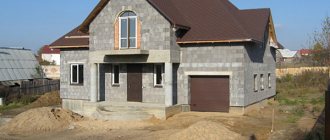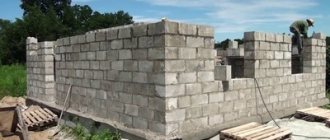Today, it is common to use concrete blocks in the construction of houses. Most often, in our country, house designs made of aerated concrete and foam concrete are used. In foreign countries, house designs made from expanded clay concrete blocks are more popular. But gradually expanded clay concrete blocks are spreading in our country. These blocks are widely used in the construction of low-rise buildings.
Two-story house made of expanded clay concrete
Features of the material
Expanded clay concrete is a structural and thermal insulation material based on artificial porous aggregates. Let's analyze this formulation in more detail to better understand the properties of this building product.
- Structural thermal insulation materials are distinguished by the fact that they can be used to build load-bearing enclosing structures, which will have sufficient thermal insulation properties so that the house can have a single-layer wall. Under ideal conditions, such walls do not require additional insulation, which is not always feasible in practice.
- The second distinctive feature is that porous materials are used as the main component, which are obtained by processing various types of raw materials: perlite, expanded clay, slag, pumice, etc. In the case of expanded clay blocks, expanded clay concrete is used as the main component.
Expanded clay concrete is obtained by mixing cement paste with expanded clay. The latter acts as a placeholder. The mixture is molded (by pressing or in formwork) and gives it the appearance of blocks; drying occurs in air. Manufacturers often add red or pink dye to the composition to give the final product a ceramic color; the original color of expanded clay blocks is gray.
Expanded clay is obtained by firing clay in drum kilns in a special way; this raw material is then used to make expanded clay concrete.
Estimated construction cost
The estimated cost of construction can be obtained by summing up the following cost items:
- development and approval of project documentation;
- purchase of materials for the construction of the foundation, walls, roof, finishing;
- transportation costs for delivery of building materials to the work site;
- expenses for the services of hired workers.
Using current prices, you can get an approximate cost and plan the amount of upcoming costs.
Characteristics of expanded clay blocks
Strength and Density
For structural materials, these are the main parameters, since the wall must withstand the weight of the roof, ceilings, and also not fall from its own weight. Increasing the reliability of a material is usually achieved by increasing its strength. At the same time, thermal conductivity also increases, that is, the block becomes “colder”. The density of expanded clay concrete is never less than grade D650 (650 kg/m3).
The strength of expanded clay concrete, which is used for the construction of single-layer walls, must be at least B2.5. This designation reflects the force applied to the area and is measured in N/mm2. Sometimes strength can be indicated in kg per cm2, in which case the brand is designated by the letter “M”. B2.5 is roughly equivalent to M35.
To determine the brand in laboratory conditions, the blocks are compressed in a press. However, in masonry these indicators are lower due to the presence of mortar. The thicker the seam between the blocks, the lower the strength of the wall. On average, expanded clay concrete provides a compressive strength of 1 MPa.
Thermal conductivity
This parameter determines the ability of the material to transfer thermal energy. Thermal conductivity has a direct relationship with density. A denser material has fewer pores with air in its structure, and accordingly it turns out “cooler”.
When building the walls of a house, it is important to find a balance between strength and density. Often private houses are built with an excessive margin of safety; as a result, the buildings turn out to be “cold” and require additional insulation.
The “warmest” expanded clay concrete blocks have a thermal conductivity of 0.21 – 0.25 W/m*C and have a density of D650. D1000 products conduct heat better - 0.4 - 0.8 W/m*C. Such walls in central Russia with a harsh climate will require additional insulation.
According to the standards, the actual thermal resistance of the wall should be at least 3 - 4 m2*S/W, the thermal conductivity of the material should be up to 0.2 W/(m*S) for structural and thermal insulation materials.
Shrinkage
Shrinkage is the deformation of masonry inside the finished structure. As a result of this phenomenon, parts of the building may sink or rise. Expanded clay concrete has a small shrinkage - 0.3 mm/m, which approximately corresponds to the same indicator for cellular concrete (0.4 mm/m). Severe distortions can lead to damage to building elements.
Seam thickness when laying
This parameter affects the possibility of using thin-seam masonry methods using polymer compositions or adhesive mineral mixtures. Thickening the seam increases material consumption, slows down work and requires higher qualifications from masons.
The permissible seam thickness depends on the geometry of the material. If the blocks are uneven, more mortar will be needed to compensate for the difference. Depending on the magnitude of the deviations, blocks are divided into the first and second categories. In the first case, laying on a 5 mm seam is allowed; in case of significant deviations, the distances must be increased. On average, for laying expanded clay concrete, a joint of 8 - 12 mm is used on a cement-sand mortar.
The quality of expanded clay concrete depends on the availability of modern equipment in production. When manufactured using a handicraft method, the geometry turns out worse.
Characteristic features of expanded clay concrete blocks
Expanded clay concrete blocks are classified as lightweight concrete, although their volumetric weight is quite large. For comparison, the volumetric weight of these blocks is twice that of aerated concrete and foam concrete. The blocks include the following components: cement, sand, expanded clay, air-entraining additives.
Let us clarify that expanded clay is hollow balls of baked clay. During manufacturing, clay is added in a certain ratio, resulting in the formation of a hardened foam. The resulting shell covers the granule and guarantees high strength and density. Therefore, expanded clay is used as a filler for large-porous fractions.
Types of expanded clay blocks
Hollow and monolithic blocks are produced, and their characteristics differ significantly. Monolithic blocks are used for the construction of fireplaces, chimneys and stoves. And hollow blocks are used for building walls.
Due to the simplicity of the manufacturing process, these blocks can be made independently.
To do this you will need a flask and a concrete mixer. Unfortunately, the big disadvantage of such production is the growth of low-quality expanded clay concrete blocks on the market, because small enterprises do not comply with production technologies. Although such errors are possible in large-scale production. Experienced builders recommend weighing blocks when purchasing. Knowing the weight, you can approximately calculate its density.
Advantages of construction
Let us draw your attention to the fact that the cost of a house made of expanded clay blocks is not very high. The main costs are for transportation. Because the blocks are quite voluminous and take up a lot of space. A way out of this situation may be to create a mini-factory right on the construction site. This will also reduce transportation costs.
If high-quality expanded clay concrete blocks were used during construction, the house can last for more than a hundred years. The features of these blocks make it possible to create various house designs from expanded clay concrete blocks. This material is quite easy to work with, its porous properties allow it to take any shape. An important aspect is the external decoration of such houses.
Option for exterior finishing of a house made of expanded clay concrete blocks
But here, too, blocks outperformed other materials. They allow designers to create a completely individual style. When finishing, you should take into account the need for insulation, waterproofing, etc.
When designing such houses, you should remember that the foundation should not be lightweight. A strip foundation is ideal, taking into account, of course, the characteristics of the soil. If the soil does not allow the construction of such a foundation, a pile or slab load-bearing foundation should be laid.
Expanded clay concrete - advantages and disadvantages
The quality of a building material can only be assessed by comparison. For some parameters, we will compare expanded clay concrete with its closest competitor, aerated concrete.
Advantages of expanded clay concrete when building a house
- High strength. The material provides high structural properties of the building. For a private house of small height, this parameter is not so important, so the benefits are more of a psychological effect.
- Less fight during shipping and handling. Compared to aerated concrete, expanded clay blocks are more difficult to damage or break.
- Slow absorption of moisture. Expanded clay blocks do not absorb moisture as quickly as aerated concrete does.
- Low shrinkage. Because of this, there is no need to install reinforcing belts in the masonry, as is necessary with aerated concrete. Expanded clay block - 0.3 mm/m, aerated concrete - 0.4 mm/m.
- High resistance to cracks. Foundation movements are less likely to lead to cracks on an expanded clay concrete wall.
Disadvantages of expanded clay block when building a house
- Relative difficulty of performing the work. Compared to aerated concrete, laying expanded clay products will require more time. Sustaining a thick seam of 8 - 12 mm requires more experience from the performer. In addition, expanded clay concrete itself is heavier than most stone wall materials.
- Longer construction time. Expanded clay concrete slowly absorbs water, but it takes a long time to release it. After production and during construction, products accumulate moisture, so after completion, time must pass before subsequent work. On average, a structure made of expanded clay concrete blocks will take longer to dry than aerated concrete.
- The inability to use thin-layer masonry leads to increased consumption of cement-sand mortar.
- The need for insulation. The thermal resistance of a wall made of expanded clay concrete does not meet the requirements for the thermal resistance of enclosing structures. For this reason, the house will need to be additionally insulated from the outside.
Insulation with vapor-proof materials can only begin after the structure has dried.
- Difficulty of processing. The blocks consist of small expanded clay granules, which can break off when sawing. In general, the material is quite hard, so it cannot be processed with a saw; for even cutting you will need a grinder.
- Thick finish. The facade made of expanded clay concrete looks unattractive, so the top of the house should be plastered. Since the material does not have a smooth surface, it is first necessary to carry out a “rough” leveling and only then a “finish” leveling. In this case, the plaster layer cannot be less than 10 mm. Additionally, the wall must be reinforced with mesh.
- Strong wind blowing. Expanded clay aggregate has a heterogeneous structure with pores of different sizes. This affects the ventilation of the house; for this reason, a wall made of expanded clay concrete must be plastered.
Expanded clay blocks with decorative facade
Expanded clay concrete blocks, like expanded clay concrete, have been known for decades and are successfully used both in private housing construction and on an industrial scale. Expanded clay blocks are a more advanced variety, since a special production technology makes it possible to obtain a material with improved characteristics.
Expanded clay blocks consist of three parts:
- internal - a thin layer of fine-grained expanded clay with a smooth surface;
- load-bearing material – large-porous encapsulated expanded clay;
- front - artificial stone with a decorative textured surface that imitates various types of natural stone.
This wall block allows you to minimize construction costs:
- the decorative facade part does not require additional finishing;
- inside, you can get by with thin-layer rough plaster/putty.
The expanded clay wall block was initially designed for low-rise construction - the construction of load-bearing walls up to three floors. In multi-storey buildings, it will seriously compete with other fillers in the monolithic frame sector.
Projects of houses 9 by 9 meters made of expanded clay blocks in Moscow
I hereby freely, by my own will and in my own interest, give my consent to IP Tsurikov Alexander Evgenievich, located at 627750, Tyumen region, Ishimsky district, Plodopitomnik village, st. Svetlaya, 2, 1 (hereinafter referred to as the Operator) for automated and non-automated processing of their personal data in accordance with the following list:
- name, telephone number, email address and other individual means of communication specified when filling out all forms on the website https://stroydom-99.ru (hereinafter referred to as the Site), namely:
- Other feedback services;
- source of access to the site and information from the search or advertising request;
- data about the user device (including resolution, version and other attributes characterizing the user device);
- user clicks, page views, field completions, impressions and views of banners and videos;
- data characterizing audience segments;
- session parameters;
- information about the time of visit;
- user ID stored in cookie
- for the purpose of providing information, providing relevant advertising information and optimizing advertising.
I also give my consent to the Operator providing my personal data to third parties, including the Tenant of the site https://stroydom-99.ru, as well as to the cross-border transfer of personal data to achieve the stated purposes of processing personal data.
In order to ensure the implementation of legal requirements in the field of personal data processing, the Operator can:
- carry out the processing of personal data by collecting, storing, systematizing, accumulating, changing, clarifying, using, distributing, depersonalizing, blocking, destroying personal data;
- use an automated method of processing personal data via the Internet;
This consent comes into force from the moment of confirmation and is valid for 5 years, unless otherwise provided by the current legislation of the Russian Federation.
Withdrawal of consent to the processing of personal data is carried out by sending a written application to the legal address of the Operator.
I confirm that I am aware of the right to withdraw my consent by drawing up an appropriate written document that can be sent by me to the Operator. In the event of my withdrawal of consent to the processing of personal data, the Operator has the right to continue processing personal data without my consent if there are grounds specified in paragraphs 2-11 of part 1 of article 6, part 2 of article 10 and part 2 of article 11 of the Federal Law of July 27, 2006. No. 152-FZ “On Personal Data”.

